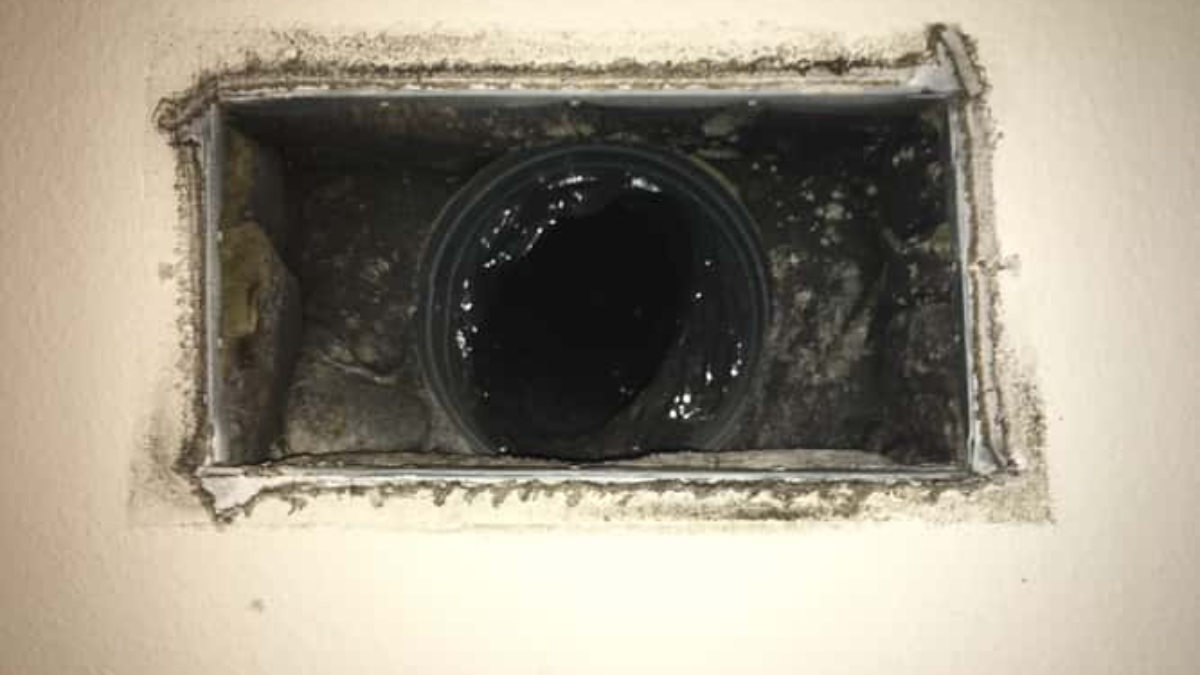7 Toxic Signs Of Detecting the Presence of Black Mold in Air Vents
It’s common knowledge that black mould harms health, but it becomes even more hazardous when it’s present in air vents. Exposure to toxic black mould can result in serious health risks, so it’s crucial to schedule regular inspections for your ducts. Additionally, awareness of the common warning signs of black mould in air vents is essential to prevent potential health hazards.
Discovering black mould in your AC or air vents can cause concern. In this article, we will discuss some of the common signs that indicate the presence of black mould in your ducts. Additionally, we will explore the available testing options and guide you on what you can do if you discover black mould in your ducts.
Recognizing the indications of the black mould is crucial in detecting it early and taking immediate action. Ignoring black mould can lead to a bigger problem that may become more difficult and costly. Below are the signs you need to know to identify black mould in your home.
7 Warning Signs of Toxic Black Mold in Your Air Vents
Strong Musty Odors
A telltale indication of black mould in air vents is a lingering musty smell. This odour persists despite efforts to eliminate it through cleaning, weather changes, or airing out your home. Therefore, it is one of the first signs of black mould growing in your air vents.
Sometimes, during the initial stages of black mould infection, you may only detect its musty odour in specific parts of your house or near particular vents. It’s essential to be particularly vigilant about any musty smell accompanying the symptoms of mould exposure listed above. If the mould has spread to your ducts, you’ll likely be able to smell it all over your home.
Your Allergies Seem to be Getting Worse
If you start experiencing a sudden worsening of your allergies, especially when you wouldn’t typically expect it, this could be an early indication of black mould in your air vents. Any unusual spikes in your allergy symptoms, which you can’t explain, could indicate that you’re dealing with black mould in your AC or vents. Attention to these signs is essential as they can be an early warning of a potential mould issue in your home.
It’s not uncommon to experience specific symptoms when suffering from allergies. These can include itchy and watery eyes, as well as itchy skin. You may also find yourself coughing or sneezing frequently or even feeling like it’s becoming more difficult to breathe, which can be reminiscent of an asthma attack.
You’re Getting More Frequent Headaches
If you are experiencing headaches daily or find that they tend to alleviate once you are away from your home, it could be a sign of black mould. Headaches are a commonly reported symptom associated with this type of mould.
Initially, the intensity of headaches might not be very high, which makes it more challenging to identify this potential warning sign. As the mould grows and expands, you may experience more intense headaches or even migraines.
You Can See Black Dust Around HVAC Vents
Inspecting your vents for signs of black dust is crucial, as it is a common but easily overlooked issue. It is recommended to check your ducts for black dust, which could indicate mould and mould spores, at least twice annually and after any flooding in your home. Don’t neglect this simple yet essential task to ensure a safe and healthy living environment.
If you’re wondering whether there’s mould growing in your vents, there are some telltale signs to look out for. You may only become aware of the dust when air is circulating through the ducts, indicating the presence of spores. Alternatively, you may notice persistent black specks around the vent, which could signify mould starting to spread in that area.
Experiencing brain fog without any underlying medical condition could be caused by black mould in your vents. This symptom can be severe and make it difficult to recognize what’s happening. Remembering that brain fog is a tough issue and seeking help as soon as you notice it is crucial.
Unexplained Fatigue
It’s not uncommon for homeowners to experience unexplained fatigue, only to later discover that black mould is the culprit. If you’re constantly tired or lethargic, inspecting your vents and looking for visible signs of mould is a good idea. However, it’s essential to remember that fatigue can also be a symptom of various medical conditions. Therefore, seeking help from a healthcare provider is crucial, just like any other health concern on your list.
Unusual Coughing or Sneezing
Experiencing upper respiratory symptoms such as coughing and sneezing without apparent cause could indicate black mould in your vents. These symptoms can occur with or without other complications and may be present even in individuals who do not have allergies or other signs of an allergic reaction. Paying attention to these symptoms is crucial as they could indicate a hidden mould problem in your home.
If you constantly cough or sneeze and your doctor can’t pinpoint the cause, it might be worth considering an inspection of your vents. This could help identify any potential issues contributing to your symptoms.
How to Test Air Vents for Mold: A Step-by-Step Guide
If you suspect that your vents might be harbouring mould, there are several ways to confirm your suspicions. The most dependable method is hiring a professional to inspect and perform mould testing. However, you can also check for mould or use a DIY testing kit as an alternative.
1. Testing Air Vents for Mold Professionally
As soon as you consult a professional, they can diagnose if there is a mold issue. Not only that, they can even distinguish between black mould and other types of fungi that may be less harmful.
2. Mold Testing Kits for Air Vents That You Can Do Yourself
If you want to test your air vents for black mould, you can use a DIY testing kit as another option. However, remember that DIY test kits are not as reliable as professional ones, and you may get a false negative if you don’t use them correctly. To avoid this, read and follow all the instructions carefully if you use a DIY testing kit. Remember that detecting mould problems early on is crucial, so don’t let a false negative delay your actions.
3. Inspecting Your Air Vents for Black Mold: A Crucial Step in Home Maintenance
If you suspect a problem with your vents, you have a few options for inspection. One option is to inspect the ducts yourself, but it’s important to note that this should be the last resort. It can be dangerous, especially if the black mould is present. However, inspecting your vents yourself may be the way to go if you’re looking for a quick and affordable solution.
Make sure to grab a flashlight before you start. Look closely at the vents in your home and check for any visible indications of black mould, dark patches, or accumulated dust. These signs, especially when accompanied by a musty or unpleasant odour, clearly indicate that your ducts are mould-contaminated and require cleaning.
If you spot black mould near your vents, you must avoid spending prolonged periods in its vicinity. This type of mould is highly toxic, and prolonged exposure can lead to long-term health problems. To tackle the issue as quickly as possible, it’s best to enlist the help of a professional duct cleaning or mould mitigation service.
How to Remove Black Mold from Air Vents?
When removing black mould from your vents, several options are available. While you may be tempted to handle the problem on your own, it is always best to seek the services of a professional mould removal company. Their expertise can ensure that mould is completely eradicated, providing a safer and healthier living environment for you and your family.
Hiring a professional’s always a good idea for a few reasons.
If hiring a professional to clean your ducts is not feasible, you can attempt to do it yourself.
To eliminate mould, you have a few options at your disposal. You can create a bleach solution by mixing 1 part bleach with 16 parts water or use either Dawn dish soap or laundry detergent. It is recommended to have a vacuum with a HEPA filter and long-handled scrubbing tools to reach into your ducts and ensure a thorough cleaning.
To effectively clean your vent covers, turn off your heating and AC systems. Afterwards, remove the covers and let them soak in your preferred cleaner for a few minutes. Once they’ve absorbed, scrub them well until they are thoroughly cleaned, then set them aside. This process guarantees that your vent covers are free from dust and any other allergens lurking in your home.
When cleaning your vents, using the right tools and cleaning solution is important to ensure a thorough job. Make sure to clean the area surrounding the vent, the inside of the vent and any part of the duct that appears dirty or mold-infected. Once you’ve finished cleaning, vacuum out the ducts to remove any remaining debris. After completing the process, reattach the vent covers and allow everything to sit and dry for a few hours before turning your heating or AC back on.
If you are still observing indications of black mould in your vents, it is imperative to seek assistance from the experts.
It’s important to prioritize regular cleaning of your vents, particularly after experiencing mould growth. Doing so eliminates the dust and particles that mould thrives on, effectively reducing the chances of mould returning. This means that even if mould spores and moisture present, you won’t have to stress about mould growth.
Signs of Black Mold in Air Vents: What You Need to Know
Identifying the initial indications of black mould in your air vents is crucial to avoid any health issues and costly removal expenses. The presence of black mould in your air vents is hazardous and could have a lasting impact on your well-being. The most prevalent complication of black mould exposure is lung damage, but other issues may also arise. Hence, it’s critical to address mould problems as soon as they emerge.
Also Read:







